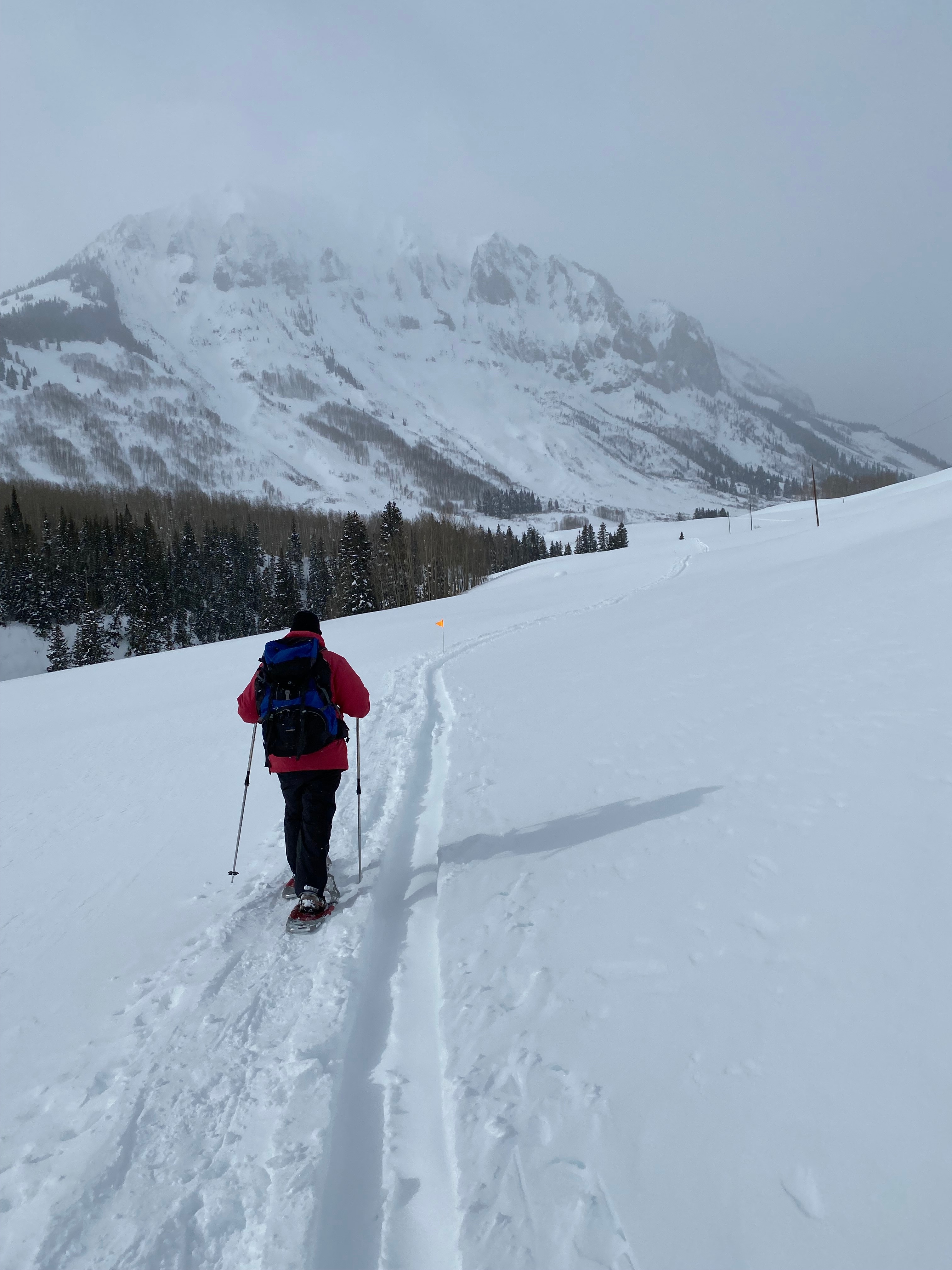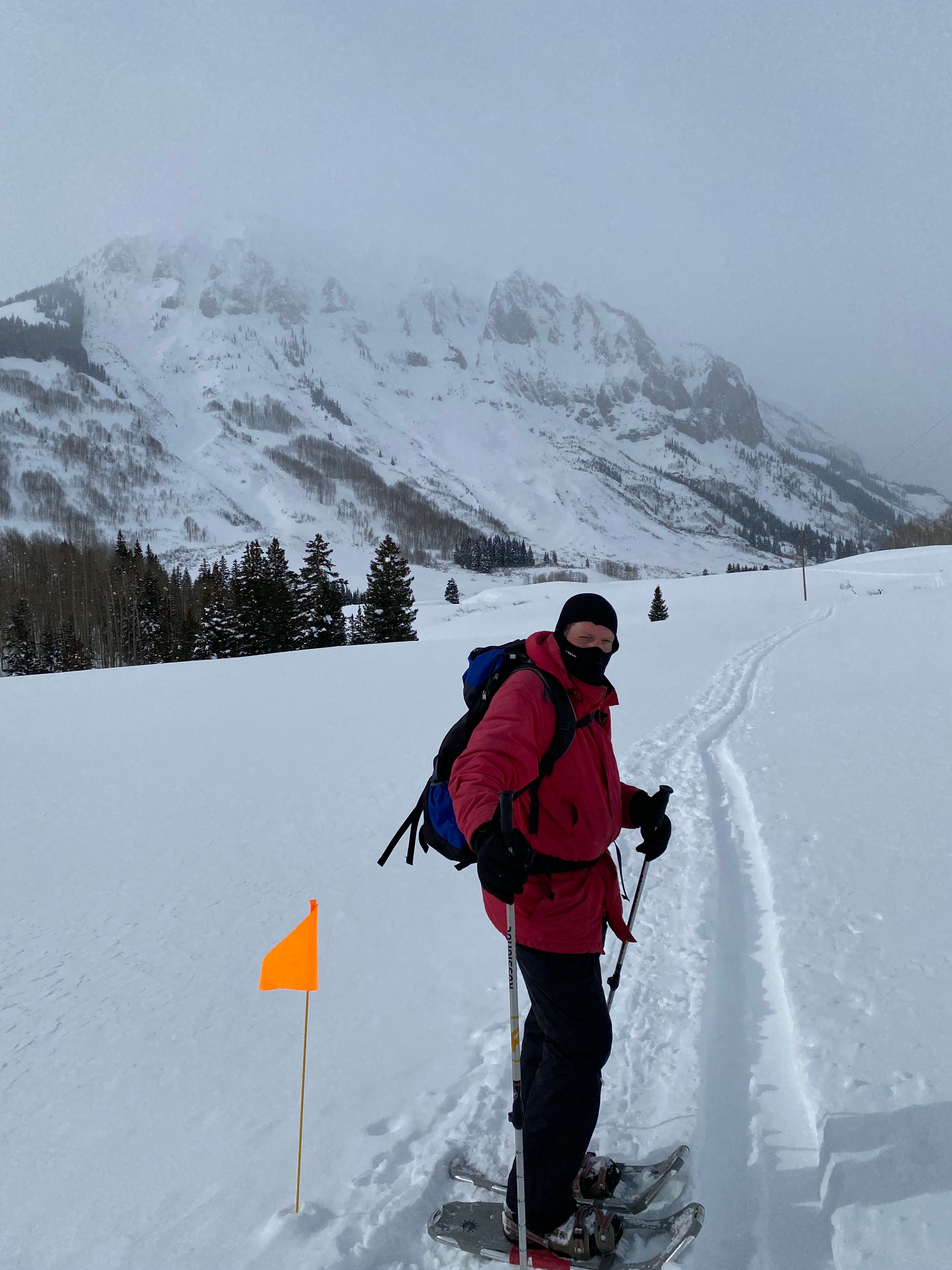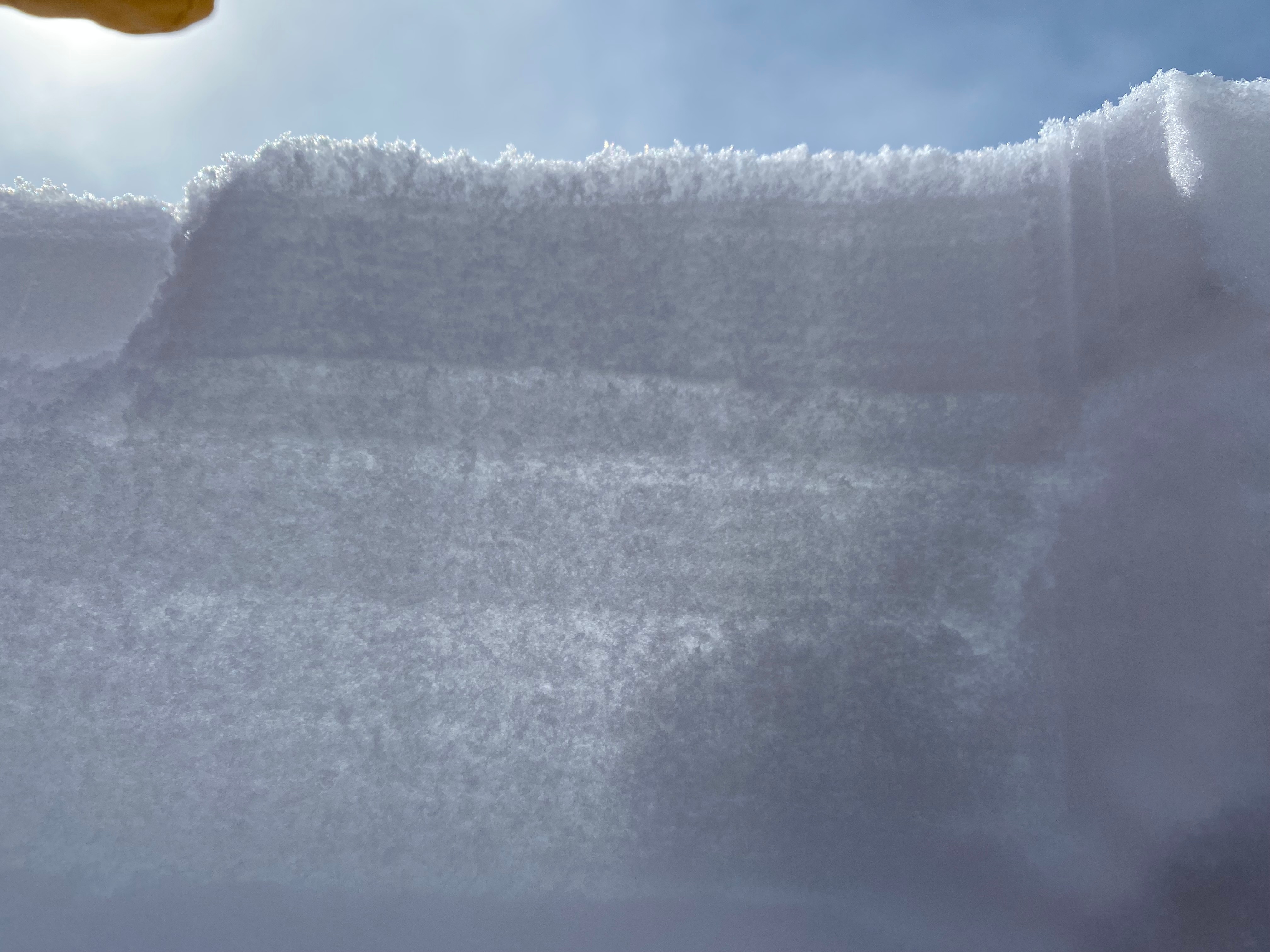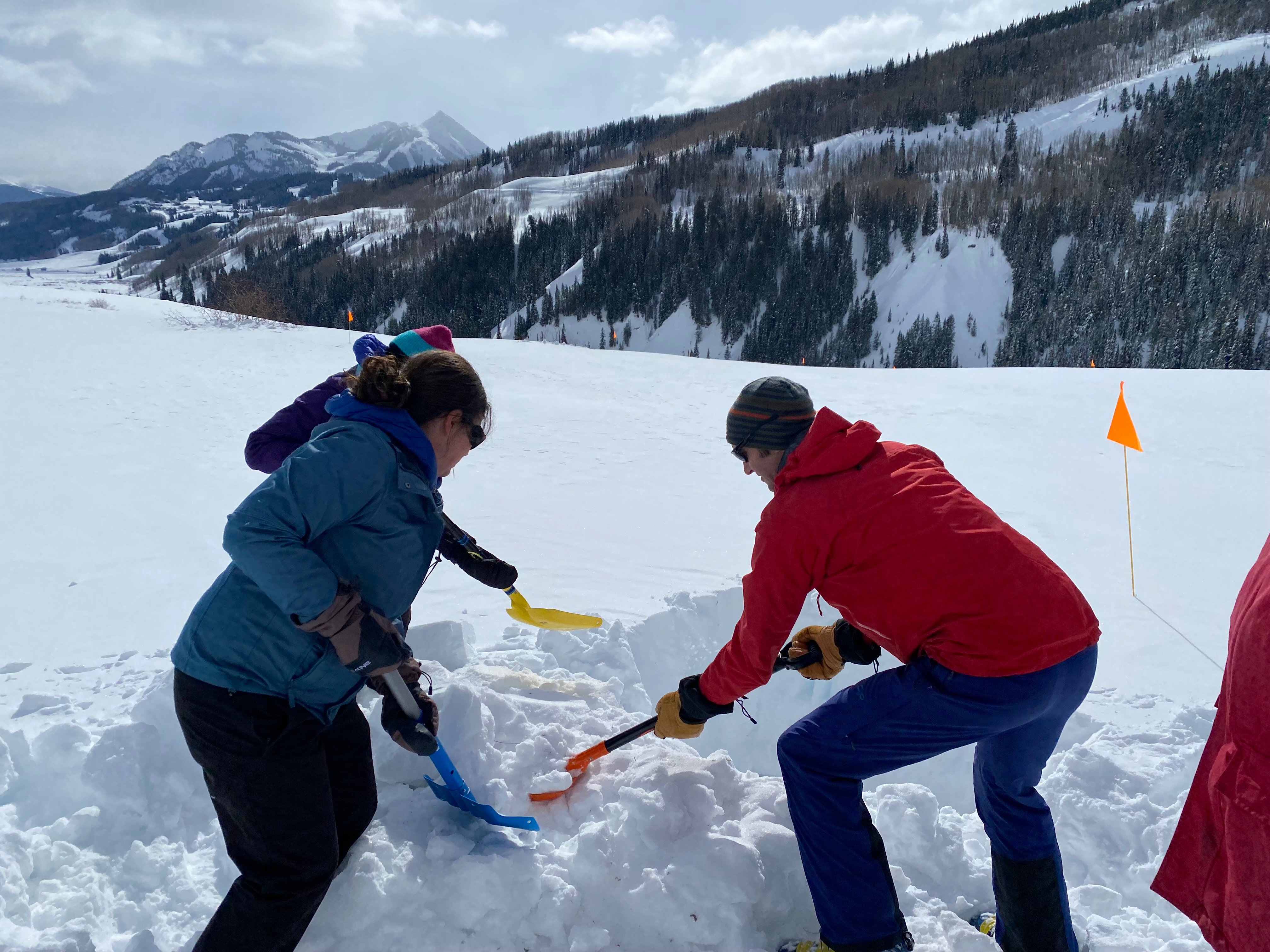Yesterday the SOS team went out to dig a snow pit up valley of Gothic near the Avery picnic ASFS deployment for SPLASH. The snow conditions were quite different from our pits down at Kettle Ponds. The snow layers were more gradual with less wind slab. Antonio and I also helped Danny troubleshoot his linear actuator thermistor. We checked for continuity across his wire connections and for any broken grounds. We found that the driver output voltage was less than the required 12V at about 9.38V. After looking at the driver and actuator diagrams, we suggested replacing the driver board ($15) to see if the output voltage increases to its required 12V.
Part of the SOS team (Ethan, Jessica, Julie, and Elise) went out to Kettle Ponds yesterday to switch out the SD cards for Ethan's LIDARs at D and UW. I proposed to Ethan that if we wanted to keep the LIDAR collection rate high, that the EOL team switches out the SD cards as apart of their ops duties.
The PIs and the majority of the SOS crew left Gothic in heavy snowfall conditions this morning. Antonio and I took some time to recoup and attend the ISF, EOL, and ISFS meetings. Danny wiped snow off the UW NR01 around 12:35 and dug a pit. Tomorrow Antonio and I will head out tomorrow morning for the drive home. Overall the PIs were very happy with the success of the IOP. Good job team!
As mentioned before, we will now proceed to change out the LIDAR USB sticks every ops shift. The procedure for doing so is as follows:
- Verify number on the USB stick to the specific LIDAR Raspberry Pi (1+2:UE, 3+4:UW, and 5+6:D) - 2/17 Ethan told me it doesn't really matter which USB stick gets put in which lidar, as long as all the USB sticks are the same size.
- Remove and replace USB sticks on the minutes ending in 2,3,7, and 8 while trying to avoid 1,4,6,9 because the card reads every minute ending in 0 and 5
- Use a reliable clock with good gps time when doing so
- At D, the lidar pis are not in the DSM box–they're in the beige box hung on the boom near the DSM. There's a screwdriver taped inside the door of the power box you can use to open it.
- Probably a good idea to check with Ethan before a visit, in case he has specific directions about specific lidars.
- Yesterday afternoon, the ue GPS started looking good again. Maybe it didn't like one of Ethan's SD cards!
- Vtherm from the Apogees has had occasional large spikes. I'm assuming this is our same popsicle stick firmware issue (for which we now have a fix). We can remove these spikes in our software with "maxValue". I'll try to get this implemented.
After an epic ski down the sluice this morning we went out to Kettle Ponds to dig a snow pit, change out the Lidar SD cards on UE (1&2) and D (5), and wipe off the radiometer for Splash. We changed out the UE cards at 14:06 and 14:08, and the D cards at 14:29. We also measured a density of 9.8% at the surface, thats Champagne Powder, baby! Time for Taco Night.
After training yesterday, Antonio took the snow pit measurements today. It was snowing lightly when we went to the site this morning, but the snow started falling much more heavily on the ski back,. This afternoon has had lots of snowfall and wind (good timing to get back to the cabins by noon).
Today Antonio and I went with the entire SOS team to learn about snow. They dug a pit and taught Antonio all about the density, layers, and deposition of surface hoar. We were also interview by the Aspen Global Change Institute while out in the field. Antonio and I also did some backcountry skiing up in Aspen Alley. That was pretty cool.
Antonio and I visited the site today to check out the GPS nsat on the ue tower. We ended up replacing the GPS antenna at 12:45 because the number of connected satellites was hovering around 3. So far the replacement has improved the connectivity, and the number hovers above 6 satellites. We will continue to monitor the changes throughout the evening.
Will and Steve skied out today. Will and Antonio skied back in. All made the transit safely.
Jessica, Danny, Eli, and Ethan went to the site and dug a snow pit. Ethan opened the box and looked at the GPS on the ue tower. He pushed the cables a bit so that the antenna was no longer crowded. It now appears to be working.
Danny and Eli set up the thermal IR sheet, and we saw some cool turbulence. It was windy (5 m/s) and very cold (-8 C) – weather to make your fingers feel numb. (Much nicer to be in the snow pit than up above.)
As of about 4pm yesterday, the number of satellites from the ue GPS is low, and we're even getting missing data from it. My guess is that something got bumped when Ethan retrieved his lidar SD memory cards. We won't deal with this tomorrow, so it will need to be looked at Wed.
Partly sunny, calm winds, top snow layer a bit softer again
Still Will and Steve and the PI team
A quick trip by Will and Steve to the site, mostly to debug the uw Apogee which had Vpile readings that were too large in magnitude. Reseating cables didn't change. Swapping the popsicle stick with a spare did help (about 10:30). Now the readings look good.
We also thought to measure the displacement between the sonic and quad-disk ports, but they are too high to measure directly. I just shot photos (soon to be attached) so that we can evaluate the distance photogrammetrically. In the process, noticed that 10m.c had blown close to the sonic, so Will climbed to shift it back. (On the tower from about 11:00 to 11:15.) I have before and after photos.
Returned in time to miss only the first few minutes of Ethan's talk to the SAIL/SPLASH team.
This is my last scheduled site visit. I'm leaving tomorrow, to be replaced by Antonio.
Jessica asked for the Apogees to be sampled faster, since these sensors should have a short time constant. I've just entered a "RAT 1" command to all 4. Hopefully, the PIC will be okay at this rate.
Also, I just found that we should have been using the "CRBasic" coefficients in my dat.Tsfc.Ap code, which are higher than the "Edlog" coefficients by a factor of 100,000. dat.Tsfc.Ap has now been updated. Unfortunately, the new code shows that Vpile.uw is now off. We'll check for a (again) cabling issue tomorrow and/or swap out the mote if we have a spare.
Today I joined Jessica, Danny, Eli, and Emilio at the field site where they dug up a pit and looked at the density of the snow at each 10 cm layer. The snow pack was at 122 cm today. Danny also installed 3 pressure sensors into the snow surface (1.1m at 10cm below snow surface (bss), 0.9m at 5cm bss, and 0.8m at 3cm bss) and left the 1.1m open but not in the snow surface. Ethan and Julie headed out to the site later in the day to pull more data from the lidar sd cards.
Overall, it was a warm and awesome day. Danny, Emilio, and Eli took me skiing in the afternoon for my first taste of powder! The SOS team is making a family dinner again, this time Cincinnati chili (:
Tomorrow we will measure the pressure port separation, look at the uw apogee cable, and try to check out the green comet C/2022 E3 (ZTF).
Cooler, a bit of wind (and thus blowing snow).
Everyone visited the site during the middle of the day. The tasks I know of:
- The PIs dug a snow pit, and explained it to us
- Danny connected a pressure inlet in the snow to P.0.8m
- Ethan downloaded 3 of his lidar SD cards
- Will climbed "d" again:
- replaced the lidar pointing at ue (I think Ethan called this #5)
- Will also managed to get the 4th bolt secured to Rsw.in's CVF4, cleaning up the small mess I made yesterday
- pointed the Apogee down a bit more (from about 45 degrees to 35 degrees)
- We also raised the barrel so its top is about 1' above the snow, rather than 1' below (for the moment!). People will have to watch it as the snowpack deteriorates as the barrel will eventually fall off of its (now) snow platform
I also appreciate that the PI's (actually Danny) established a different 2-track to the site, so I now have my own snowshoe track.
Overcast, making it feel colder, but making the snow cruchier (and thus a bit easier to walk)
Tony left today – Home duties called (or was it cried)? We chose not to accompany him, since avalanche conditions are only Moderate. We did arrange walkie-talkie check-ins every 15-30 minutes, and Will and I went to Kettle Ponds at the same time, so we had a good connection. By the time he got to the trailhead (about 1:40 total trip), we were at Kettle Ponds and were able to communicate with our phones. Thanks for your help and great attitude, Tony!
At the site, we did our remaing tasks:
Arrived at site at 0938
Read pillow serial numbers:
Pillow SN 1 22001 2 22003 3 (the one we opened) 22004 4 can't read due to the way it is mounted - secured the Tsnow mote box
- replaced the cap on the DSM port for the EC100 at 1m.c, that we had disconnected yesterday.
- most of the time was working on Rsw.in.9m.d. Indeed, its fan wasn't running (the other 3 were working). Ultimately, I think the problem is a loose connection in the Lemo(?) connector at the end of the K&Z yellow cable. This connector has a hex nut and also a knurled "nut" for tightening. On this one cable, the hex nut was loose and it was very hard to turn the knurled nut without further loosening the hex. In the end, I swapped this cable with the ventillator for Rsw.out.9m.d, but miraculously, it stayed connected and was working when I left.
- It was hard, doing all this since the Rsw radiometers are at the far end of the boom, requiring a long reach. The only way I could manage was to remove the entire Rsw.in radiometer and ventillator plate. We had brought an extra, so I went ahead and swapped it in even though I was able to get the old ventillator fan running connected to a different yellow cable. I could only get 3 of the 4 bolts holding the ventillator to its standoffs. I left the 4th loose inside the housing. We just need to loosen the bottom of the standoff, but I didn't have a wrench. Maybe later this visit. All this took almost 2 hours, with me taking several breaks just to stretch and put my gloves back on. Poor Will had to stand on his skis below me the entire time. Sorry, Will!
- At 1208, I cleaned all radiometers and came down.
- Had lunch, left site about 1310.
Jessica, Ethan, and team arrived at (their) cabin about the same time that we got back to ours.





















